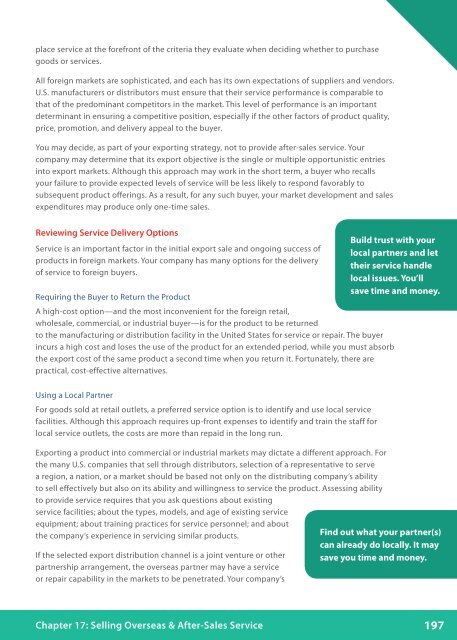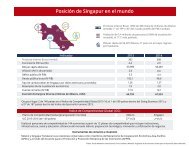basic-guide-to-exporting_Latest_eg_main_086196
basic-guide-to-exporting_Latest_eg_main_086196
basic-guide-to-exporting_Latest_eg_main_086196
You also want an ePaper? Increase the reach of your titles
YUMPU automatically turns print PDFs into web optimized ePapers that Google loves.
place service at the forefront of the criteria they evaluate when deciding whether <strong>to</strong> purchas<strong>eg</strong>oods or services.All foreign markets are sophisticated, and each has its own expectations of suppliers and vendors.U.S. manufacturers or distribu<strong>to</strong>rs must ensure that their service performance is comparable <strong>to</strong>that of the predominant competi<strong>to</strong>rs in the market. This level of performance is an importantdeterminant in ensuring a competitive position, especially if the other fac<strong>to</strong>rs of product quality,price, promotion, and delivery appeal <strong>to</strong> the buyer.You may decide, as part of your <strong>exporting</strong> strat<strong>eg</strong>y, not <strong>to</strong> provide after-sales service. Yourcompany may determine that its export objective is the single or multiple opportunistic entriesin<strong>to</strong> export markets. Although this approach may work in the short term, a buyer who recallsyour failure <strong>to</strong> provide expected levels of service will be less likely <strong>to</strong> respond favorably <strong>to</strong>subsequent product offerings. As a result, for any such buyer, your market development and salesexpenditures may produce only one-time sales.Reviewing Service Delivery OptionsService is an important fac<strong>to</strong>r in the initial export sale and ongoing success ofproducts in foreign markets. Your company has many options for the deliveryof service <strong>to</strong> foreign buyers.Requiring the Buyer <strong>to</strong> Return the ProductBuild trust with yourlocal partners and lettheir service handlelocal issues. You’llsave time and money.A high-cost option—and the most inconvenient for the foreign retail,wholesale, commercial, or industrial buyer—is for the product <strong>to</strong> be returned<strong>to</strong> the manufacturing or distribution facility in the United States for service or repair. The buyerincurs a high cost and loses the use of the product for an extended period, while you must absorbthe export cost of the same product a second time when you return it. Fortunately, there arepractical, cost-effective alternatives.Using a Local PartnerFor goods sold at retail outlets, a preferred service option is <strong>to</strong> identify and use local servicefacilities. Although this approach requires up-front expenses <strong>to</strong> identify and train the staff forlocal service outlets, the costs are more than repaid in the long run.Exporting a product in<strong>to</strong> commercial or industrial markets may dictate a different approach. Forthe many U.S. companies that sell through distribu<strong>to</strong>rs, selection of a representative <strong>to</strong> servea r<strong>eg</strong>ion, a nation, or a market should be based not only on the distributing company’s ability<strong>to</strong> sell effectively but also on its ability and willingness <strong>to</strong> service the product. Assessing ability<strong>to</strong> provide service requires that you ask questions about existingservice facilities; about the types, models, and age of existing serviceequipment; about training practices for service personnel; and aboutthe company’s experience in servicing similar products.If the selected export distribution channel is a joint venture or otherpartnership arrangement, the overseas partner may have a serviceor repair capability in the markets <strong>to</strong> be penetrated. Your company’sFind out what your partner(s)can already do locally. It maysave you time and money.Chapter 17: Selling Overseas & After-Sales Service197





